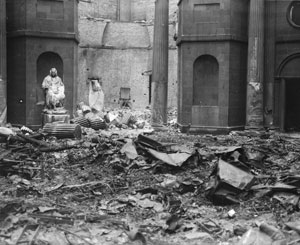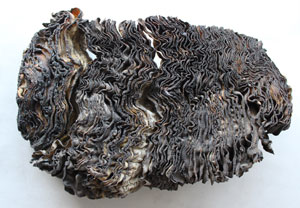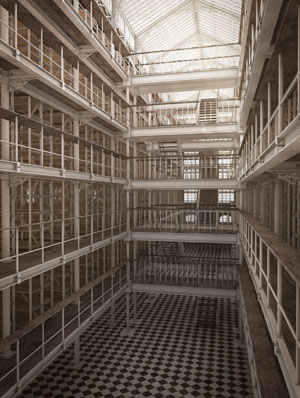RADIO EAR: Charred remains
Published in UncategorizedProduced by Patricia Baker
Newstalk 106–108FM,
3 February 2019
By John Gibney
Harry Clarke’s haunting image The last hour of the night serves as the frontispiece for Patrick Abercrombie’s Dublin of the future (1922), one of numerous grandiose plans for the reconstruction of Ireland’s capital city over the centuries. Devised prior to the First World War, it was not published until the 1920s, when the damage inflicted on the city by the revolution seemed to offer an opportunity for reconstruction. Clarke’s image depicts a Nosferatu-like figure holding a lamp and surrounded by depictions of, amongst other things, the three great Georgian public buildings destroyed in the revolution: the GPO, the Customs House and the Four Courts. The implications of the latter’s destruction is the subject of Patricia Baker’s intriguing documentary, for while all three buildings have been rebuilt and function in the 21st century, the fate of their original contents is another matter.

Above: The wrecked main hall of the Four Courts. Most of the original medieval court rolls were destroyed on 30 June 1922 in the explosion in the nearby Public Records Office (PRO). (NLI)
Mention the outbreak of the Irish Civil War and the image that usually springs to mind is a vast plume of smoke emerging from Dublin’s Four Courts on the north quays of the River Liffey in June 1922. This was the result of the fires that took hold in the Public Record Office (PRO) within the complex after the anti-Treaty IRA, who had occupied the Four Courts the previous April, were attacked by the pro-Treaty National Army. The whys and wherefores of who was responsible was not the subject of Charred remains (that will be addressed in the next issue of History Ireland!); rather, Baker’s intriguing and engaging documentary tackled the questions of what was lost, what that loss meant and how, in the 21st century, it might be retrieved.
The destruction of the Irish PRO was not the first time that large quantities of records had been destroyed by fire in Ireland but it was by far the most devastating loss. The purpose-built repository had opened in 1867 within the precincts of the Four Courts, and its construction arose from a Victorian impetus for the collation, preservation and publication of archival records (students of medieval and early modern history can attest to the heroic labours of those who published such material in the nineteenth century). The destruction of the PRO in one fell swoop in June 1922 deprived the new Irish state of an extraordinary treasure trove of records. Ciaran Wallace of Trinity College Dublin (one of a number of archivists and historians interviewed here) offered up vivid descriptions of scraps of ancient documents being retrieved after the fire from as far away as Howth. According to Zoe Reid of the National Archives of Ireland (NAI, the post-independence descendant of the PRO), over 200 boxes of ‘salved’ material remain in their keeping. These are, however, drops in the ocean: the loss was incalculable, as visitors to the National Archives and genealogists will be painfully aware.
What records were lost? In essence, the holdings of the PRO were the administrative records of the British state in Ireland, going back to the English conquest of the twelfth century and extending up to 1922. These were political, bureaucratic and even ecclesiastical records (the Church of Ireland was essentially an arm of the State until its disestablishment in 1869) and census returns: all were destroyed. There were some ruminations from Catriona Crowe and Diarmaid Ferriter (both of whom have, along with many others, done their bit to make Irish archives more widely known and publicly accessible) on the potential cultural impact of this, but there is another discussion that could be had over how precisely this has hamstrung Irish historians. It naturally has implications for the meat-and-two-veg political history traditionally assumed to be the stock-in-trade of the Irish historian, but it has huge implications for social and economic history on the ground, which can often be difficult to fully retrieve. And as Peter Crooks of TCD noted here, when records are scarce in the first place the impact of their destruction is magnified; the lacunae for the medieval period, for instance, are particularly stark.

Above: The charred remains of a large roll of parchment—‘Common Law: Writs to execute judgement 1820’. Scraps of ancient documents were retrieved from as far away as Howth. (NAI)
The records that historians use are not compiled with them in mind, and what those records reveal can depend on what is asked of them. Some of the most innovative historical writing of the past century has been undertaken by historians of the medieval and early modern period (the so-called Annales ‘school’ in France comes to mind) obliged to milk every last drop from sources that are scanty compared with the abundant material at the disposal of modern (post-1800) historians. One could dismiss the records destroyed in the PRO as simply the records of British government in Ireland, but they are also the records of how British government engaged with Ireland from 1169 onwards and as such would have had the potential to illuminate the lived experience of the Irish past in ways that will remain forever elusive.

Above: The Beyond 2022 project’s digital reconstruction of the interior of the Record Treasury, showing empty repositories awaiting virtual records. (Beyond 2022/Noho)
On the other hand, one can have an overly narrow view of primary sources as exclusively consisting of documentation. Geography, material culture, archaeology and the printed word can all be deployed to reveal the past. There are other archives out there (such as the National Folklore Collection based at UCD). And the extent of what has survived from the past can be surprising. A running feature of the documentary was the existence of the remarkable Beyond 2022 project (https://beyond2022.ie), led by Peter Crooks and based in TCD. This is intended to be a virtual reconstruction of the old PRO, to be launched in 2022 and populated by digital copies of the material destroyed a century earlier. Thanks to the work of scholars and antiquarians prior to 1922, copies of a good deal of the original material destroyed survive worldwide and, with the benefit of technology, can be located and replicated. The gap left by the destruction of the Irish PRO in 1922, as explored by Baker and her interviewees, can be plugged to some degree, which also allows for commemorating the centenary of the outbreak of the Civil War in a more positive manner than might be expected.
https://www.newstalk.com/podcasts/newstalk-documentary/charred-remains-documentary-on-newstalk
John Gibney is Assistant Editor with the Royal Irish Academy’s Documents on Irish Foreign Policy series.
















